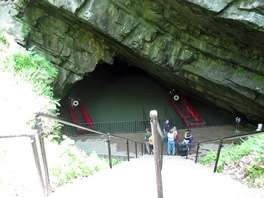What is a cave?
A cave is an opening (natural) occurring beneath the surface of the earth that is big enough to allow entry to a normal sized human being. They occur with a wide variety of rock types and are caused by differing geological formations and processes. Caves can range in size from caves the size of small rooms to the long formations that are miles upon miles long. The scientific study of caves is called speleology.
 Penn's Cave
Penn's Cave
Penn's cave is located in a region of Pennsylvania known as the RIDGE AND VALLEY section of the Appalachian Highlands. Penn’s Cave limestone formed from ocean bottom mud compressed into rock over millions of years. This rock is an estimated 400-500 million years old. Penn’s Cave follows the linear cave pattern, which in geological terms means its tunnel forms a rather straight passage along the strike of limestone formations. The cavern itself is thought to have formed in two cycles: the dissolving of limestone rock from acidic groundwater, and draining of water through naturally-formed cavities, essentially fractures in the typically impermeable limestone. Centuries of this dissolution caused the fractures to enlarge into cave passages. Additionally, because Penn's Cave is a major drainage basin for the western portion of the valley, it is has constant water present and a water flow (movement). The water level in the cave varies with the seasons. Penn’s Cave is estimated to be about 30 million years old, which is much older than the average cave age of 10 million years.
 Cave Features
Cave Features
Penn's Cave is decorated with numerous cave features. These features have been formed from surface water seeping through joints in the cave walls. This surface water has a high calcite (a mineral) content. As the water drips away, a little of the calcite mineral is deposited. These mineral continue to accumulate (build up) over time forming the amazing cave features. This process of forming varies from 300 to 500 years per linear inch!
Stalactites hang downward from the ceiling and are formed as drop after drop of water slowly trickles through cracks in the cave roof. Tubular or "soda straw" stalactites grow when drops of water add ring below ring of calcite (the water drips through the hollow center of the rings), until a cylinder forms. The large cone-shaped stalactites begin as these fragile tubes and then enlarge to cones when enough water accumulates to flow along the outside of the soda straws. Deposition of calcite on the outside of the tubes, most of which are near the ceiling and taper downward, results in the familiar cone shapes.
Stalagmites grow upward when the dripping water strikes a ledge or bank of the cave. The water runs off these ledges, leaving the heavier mineral deposit behind.
When stalactites (formations from the ceiling that move downward) meet stalagmites (formations that move from the ground upward), they form columns or pillars.
A curtain or drapery begins to form on an inclined ceiling when the drops of water trickle along a slope. Gradually a thin sheet of calcite grows downward from the ceiling and hangs in decorative folds like a drape. Flowstone is formed when sheets of calcite are deposited on the walls or floor by flowing water.
The posted coordinates are for the entrance to the Penn's Cave complex. You must proceed to the visitor's center to purchase tickets for the 1-hour boat tour of Penn's Cave. Please visit www.pennscave.com for details regarding pricing, hours, etc.
In order to log this Earthcache, you must email Team Wiji (see profile for email) the answers to the following questions. Hint: Listen closely to your tour guide!
1. What is the depth of the water at the entrance (boat dock)?
2. What is the length of the largest stalagmite in the cave? What is the 'nickname' given to this feature?
3. Why does the cave feature which provided 'music' to the caves no longer work? Is this a stalactite or a stalagmite?
4. -OPTIONAL- Post a photo of your GPSr and/or your team at the top of the stairs where the descent to the boat tour begins. You may include this photo in your log.
++ Congratulations to mountainfolk406 on the FTF!! ++